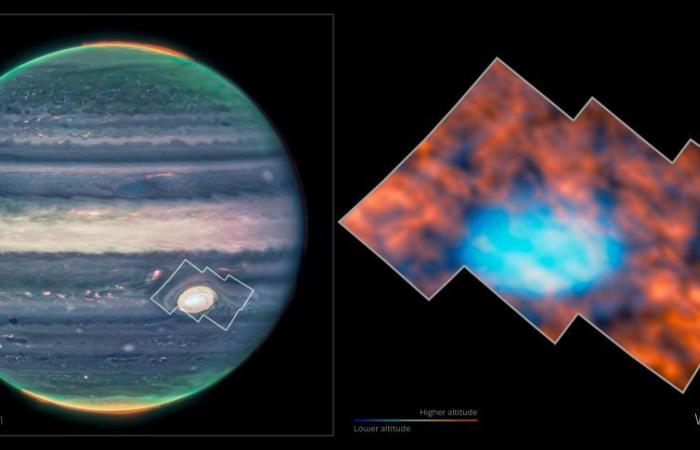Infrared image of the planet Jupiter, taken by the NirCam of the JWST. The planet is shown in multiple colors, especially at the poles and on the Great Red Spot, visible as a circular storm in the lower right of the planet. Credits: Esa/Webb, Nasa & Csa, Jupiter Ers Team, J. Schmidt, H. Melin, M. Zamani (Esa/Webb)
Although visible to the naked eye on clear nights, Jupiter’s atmosphere is so faint that it is difficult to observe in detail with ground-based telescopes. However, just below the Jovian equator, it is easy to spot a turbulent, reddish area called the Great Red Spot, which has become a distinctive feature of the giant planet.
With an extension and depth such as to be able to contain three times the Earththe largest anticyclonic storm in the Solar System has surprised scientists who, thanks to the sensitivity in the near and mid-infrared of the James Webb Space Telescope (JWST), have been able to examine New details of Jupiter’s upper atmosphere just above the Great Red Spot.
According to a recent study published in Nature Astronomy by an international research team led by the University of Leicester, UK, thered eye of jupiter would present a series of new features and a more complex atmosphere than expectedThe discovery was possible thanks to the Integral Field Unit of NirSpec which, in the first observations of 2022, focused precisely on the Great Red Spot, detecting the presence in Jupiter’s upper atmosphere of a variety of complex structures, dark arcs and bright points.
Jupiter’s upper atmosphere is the interface between the planet’s magnetic field and the atmosphere below it, and is composed of a neutral thermosphere and a charged ionosphere. In this region, bright displays such as vibrant auroras fueled by volcanic material ejected from Jupiter’s moon Io can be observed. Closer to the equator, the structure of the planet’s upper atmosphere is influenced by incoming sunlight, but because Jupiter receives only 4% of the light that reaches Earth, astronomers have previously thought it was rather calm and homogeneous.
But appearances can often be deceiving. JWST observations of Jupiter’s ionosphere at low latitudes, where the Great Red Spot is located, have shown unexpected small-scale intensity features such as arches, bands and spots suggesting that the ionosphere there is strongly coupled to the lower atmosphere via overlapping gravity waves to produce this complex and intricate morphology. “Perhaps naively, we thought this region was really boring,” he says. Henrik Melin of the University of Leicester, the study’s lead author. “It’s actually as interesting as the Northern Lights, if not more so. Jupiter never ceases to amaze.”
The image captured by the space telescope was obtained from six different shots, each of about 300 square kilometers, and showed the infrared light emitted by the hydrogen molecules in Jupiter’s ionospheremore than 300 kilometers above the clouds of the Great Red Spot, where sunlight ionizes hydrogen and stimulates infrared emission.
This image shows the region observed by Webb’s Near-InfraRed Spectrograph (NIRSpec). It was stitched together from six NIRSpec Integral Field Unit images taken in July 2022, each covering about 300 square kilometres. Infrared light is seen from hydrogen molecules in Jupiter’s ionosphere more than 300 km above the storm clouds. The redder colours show hydrogen emission in the upper ionosphere; the bluer colours show infrared light from lower levels, including cloud tops and the Great Red Spot. Credits: Esa/Webb, Nasa & Csa, Jupiter Ers Team, J. Schmidt, H. Melin, M. Zamani (Esa/Webb)
According to the research group – which involves, among others, Alexander Walls of the INAF in Rome – the light emitted by this area could be influenced not only by sunlight but also by gravity waves, generated in the turbulent lower atmosphere around the Great Red Spot. Atmospheric waves that – also present on Earth, but less intense than on Jupiter – would rise in altitude, modifying the structure and emissions of the upper atmosphere.
“One mechanism for changing the structure is gravity waves, similar to waves crashing onto a beach and creating ripples in the sand,” Melin explains. “These waves are generated deep in the turbulent lower atmosphere, around the Great Red Spot, and can travel up, changing the structure and emissions of the upper atmosphere.”
The observations – part of the first data collected by the James Webb in the program Early Release Science #1373 (Ers) from NASA – they initially aimed to explore temperatures above the Great Red Spot. “The Ers proposal was written in 2017,” he recalls Imke de Pater, researcher at the University of California and co-author of the study. “The new data showed very different results from our initial expectations.”
Jupiter’s atmosphere, therefore, is proving to be much more fascinating than expected, so much so that the team is planning further observations to better understand the movement of waves in the upper atmosphere and the energy balance of the region. In the meantime, the information obtained so far will provide valuable support for ESA’s Jupiter Icy Moons Explorer (JUICE) mission, which, launched on 14 April 2023, will carry out detailed observations of the gas giant and its moons Ganymede, Callisto and Europa, exploring Jupiter’s complex environment with a series of advanced instruments – remote sensing, geophysical and on site – characterizing them both as planetary objects and as possible habitats.
To know more:
- Read on Nature Astronomy the article “Ionospheric irregularities at Jupiter observed by JWST”, by Henrik Melin, J. O’Donoghue, L. Moore, TS Stallard, LN Fletcher, MT Roman, J. Harkett, ORT King, EM Thomas, R. Wang, PI Tiranti, KL Knowles, I. de Pater, T. Fouchet, PH Fry, MH Wong, BJ Holler, R. Hueso, MK James, GS Orton, A. Mura, A. Sánchez-Lavega, E. Lellouch, K. de Kleer and MR Showalter



